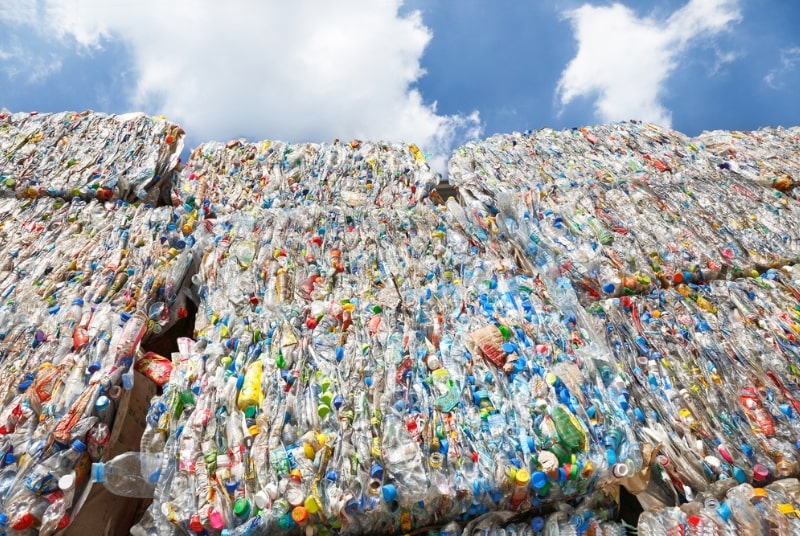Plastic Pollution & Recycling Best Practices
The invention of plastics boosted an innumerable number of innovations that improved the quality of life worldwide. It indeed has helped humanity to succeed in lots of industries. But let's look at the other, much darker side, and we'll see that the invention of plastics created almost equal problems. To name just a few of them:
- Plastic pollution - being used in various spheres and industries, plastic is hard to reuse and recycle, meaning it keeps polluting the environment: oceans, rivers, and landfills, causing harm to wildlife and the environment;
- Health consequences - plastic pollution that enters the food chain can have significant health consequences for humans and wildlife. Microplastics have been discovered in seafood, water, and even the air we breathe;
- Landfill space - because plastic garbage decomposes over hundreds of years, it consumes valuable landfill space that could potentially be utilized for other debris;
- Carbon emissions - plastic production adds to carbon emissions, which in turn causes harmful and rapid climate changes;
- Plastics are often created from nonrenewable components such as oil and gas, which are finite resources and will eventually be consumed by world needs;
- Toxicity - some plastics contain hazardous compounds that can leak into food or water, causing poisoning;
- Damage to the environment - the manufacture of plastics causes artificial deforestation, habitat damage, and other environmental difficulties;
- Impacts on marine life - once swallowed by fish plastic causes injury or death of underwater fauna, big sea, or ocean mammals;
- Recycling difficulties - many plastics are difficult to recycle due to their chemical composition or a lack of recycling infrastructure;
- Costs of garbage management - collecting, transporting, and disposing of plastic waste can be enormous, putting a strain on local governments and communities.
Nowadays, plastic is used in everything from packaging to construction to electronics and more. But its widespread use has exacerbated the problem of plastic pollution. Plastic pollution is a significant environmental issue with substantial consequences for the health of our planet, and taking some steps to stop and prevent pollution is crucial for humanity's sustainable future. Recycling is one of the most effective strategies to fight plastic pollution, so let's explore various recycling options available and how efficiently they reduce plastic pollution.
Plastic pollution is a rising threat that impacts oceans, rivers, and landfills. According to the United Nations, about 8 million tons of plastic waste end up in oceans every year. Plastic pollution not only hurts underwater flora and fauna, but it also harms food chains and human health. In addition, it takes hundreds of years for plastic garbage that is taken to landfills to decompose, resulting in a long-term environmental crisis.

Recycling Methods
There are various methods of recycling plastic trash: mechanical, chemical, and energy recovery. Mechanical recycling is the most common one. It entails collecting and sorting plastic garbage that is subsequently melted down to make new items. This method allows for recycling materials like PET bottles, HDPE bottles, and others. Mechanical recycling is a relatively low-cost method of recycling plastic trash that has already been implemented by several countries worldwide.
The chemical processes approach helps to break down plastic trash into reusable components. The finished products can further be used to make new items. Chemical recycling is used to recycle a broader spectrum of plastics, such as multi-layered and potentially hazardous, contaminated plastics. However, it is a more complex and costly process when compared to mechanical recycling.
The energy recovery method allows producing energy by burning trash and generating heat power that is transformed into electricity. This method helps eliminate contaminated plastic that can not be reused or disposed of in any other way. However, this method is considered to be inappropriate in a range of countries as it requires burning plastic waste which anyway produces CO2 emissions that are harmful to the environment.
Several countries worldwide have already implemented various successful recycling methods to decrease plastic pollution and avoid it in the future. The Netherlands, for instance, organized highly effective waste management processes that included plastic trash sorting and recycling. The country has a recycling rate of 81% for all plastic packaging waste. These statistics cover the sorting and recycling of all the food covers and tetra packs.
Germany also succeeded in plastic waste reduction through its recycling program. The country has a recycling rate of 56% for plastic packaging waste and has implemented a deposit system for plastic bottles to encourage society to recycle more.

Recycling waste plastics into paving slabs is one of the brightest examples of reusing excessive plastics with great purpose. This recycling method requires plastic garbage to be collected, cleaned, and shredded into smaller pieces and further melted into a liquid state. After that, the shredded and melted substrate is mixed with sand or concrete and formed into paving slabs. These paving slabs are ready to be used in just a few hours after production. Such pavement is long-lasting, sturdy, and weather-resistant. It’s also environmentally friendly because it’s made of recycled materials, reducing the quantity of plastic waste in landfills and oceans.
Recycling enormous amounts of plastic waste that is stored in landfills into pavement slabs offers a whole range of benefits to society. First of all, it’s a very useful and effective way to get rid of excessive plastic waste and make it useful for the long term. Instead of just storing this environmentally dangerous trash or just burning it to declutter landfills, this innovation provides a second life to materials that anyway won’t be ever used by people.
This not only minimizes the amount of plastic thrown into the environment but also saves finite natural resources and somewhat prevents new plastics from being generated.
Secondly, paving slabs that are made from recycled materials and sand are a few times more durable compared to concrete pavement. It’s crack-resistant and can withstand harsh weather conditions, making such slabs ideal for outdoor placement. The light weight of such paving slabs simplifies the transportation and installation of such a product.
Thirdly, the cost of producing this type of pavement is much cheaper when compared with concrete pavement. The manufacturing process is also significantly less expensive than traditional methods. Recycled materials reduce the cost of raw materials used for production. All these aspects make recycled plastic paving slabs an affordable, sustainable, and cost-effective option for landscaping projects or charging stations and mini power plants as MASWES.
Another quite worthy factor is that reusing waste plastics into paving slabs helps reduce the global carbon footprint of humanity. Traditional paving slab production entails the use of fossil fuels and the emission of greenhouse gases. Recycling, on the other hand, consumes less energy and produces less CO2. This lowers carbon production & contributes to a more sustainable future.
The first documented case of recycling waste plastics into paving slabs is dated 2002. An Indian engineer Rajagopalan Vasudevan then examined a process of creating a binding agent out of melted plastic waste and using it for asphalt road surface production. Since that time this method was greatly improved and is widely used in various road construction projects in India and other countries. In 2005 Scottish company Plasphalt started mixing waste plastics with bitumen to produce more durable road surface materials. In 2010 a Dutch company called The Plastic Road developed a method of creating paving slabs from recycled plastic. Such slabs were widely used for sidewalks, driveways, and a range of small-scale applications. The next breakthrough was made by them in 2018 when the company created a bike path made from recycled plastic waste in the city of Zwolle. The path was created of modular paving slabs, each of which contained the equivalent of about 218,000 plastic cups.
To sum things up, recycling waste plastics into paving slabs is a solution that can help future generations to slow down or even fully prevent plastic waste production. It can help improve the environment and reduce the pollution level of the land and oceans for decades and stop the conservation of undecomposable resources. It is a long-lasting, cost-effective, and eco-friendly solution for landscaping projects. As society strives for a more sustainable and brighter future, projects like this one show that by rethinking how we use and dispose of plastics, we can have an impressive impact on the world.
